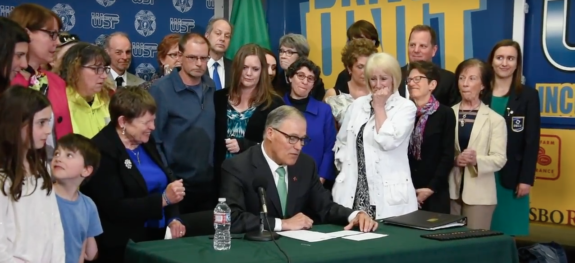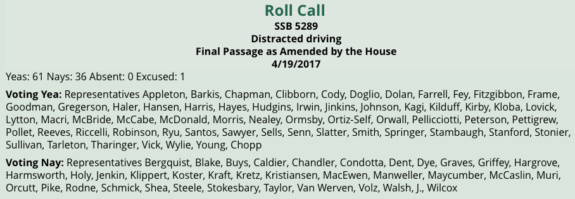
In three months, it will finally be illegal to flip through Facebook or watch Netflix on your phone while driving a car in Washington State.
Though Washington was among the first state’s to ban texting while driving, the state has been slow to update it’s laws to outlaw other mobile device uses as the technology evolved beyond just text messaging.
It took several years of failed bipartisan efforts (House Democrats killed a similar bill in 2015 after Republicans passed it in the Senate) before the legislature finally passed SSB 5289 (PDF) this session to outlaw using a “personal electronic device” while driving. This includes holding the phone at all while talking (you can no longer just hold it in front of your face, which was actually legal before), watching video (this was also somehow legal until now), and using your finger to do anything more than activate a function on a device (so you can still answer a call on speaker, for example, or skip a song on Pandora).
Before signing the bill into law Tuesday, Governor Jay Inslee struck a provision that would have delayed the law’s effects until January 2019.
“We can’t wait that long,” he said, surprising the bill’s supporters and eliciting a round of applause. It was a moment of truly great leadership from Governor Inslee. Because he’s right. There’s no reason why people need another year and a half of streaming Netflix while driving.
The law goes into effect 90 days after the signing, which is actually months sooner than the original January 2018 date.
Thank you to all the loved ones of people killed or seriously injured due to distracted driving who fought long and hard for this to become law. Their powerful testimony gave this bill the momentum it needed to overcome years of stalling.
Senator Ann Rivers (R-La Connor) also deserves credit for being a persistent champion of the bill in her party and the Senate. This new law is a flash of true bipartisanship in an era where that happens less and less often. Republicans and Democrats landed on both sides of this vote.
In fact, the vote could even have implications in the Seattle mayoral race. Newly-announced Candidate Bob Hasegawa was one of just ten “no” votes in the Senate. Jessyn Farrell, another new candidate for Mayor, was a sponsor of the bill in the House. Here’s the final roll call:










Comments
6 responses to “Governor vetoes delayed rollout of distracted driving law: ‘We can’t wait that long’”
Please explain how the Governor is able to strike the delayed roll out? Is there a line item veto? Were these separate bills? I’m unclear on the legislative logistics. Thanks.
Line item veto. Section 5 set the date as January 2019. He struck that.
How many people have actually been charged under the existing law? Very few, though we see it violated routinely. It’s hard to see from behind the wheel of a police car and it’s hard to demonstrate after a collision or an observation of erratic driving.
Laws setting out specific behaviors as “distracted” are useless. If you plow into someone that clearly has the right-of-way, especially a pedestrian or cyclist, and your excuse is, “Well I just didn’t see ’em,” you’re failing in the basic responsibilities you agreed to in order to get a drivers’ license. If we aren’t going to uphold that standard as a condition of holding a license, what does a driver’s license even mean? An agreement to not drive black-out drunk all that often? If our politicians, our police, and our courts are so lax on the basic responsibilities of drivers they don’t deserve photo-ops for this sort of superfluity.
This right here. All these laws (distracted driving, 20 MPH/30 MPH speed limits, etc) are great, but they are really just smoke and mirrors until SPD and WSP get serious and beef up their traffic enforcement numbers.
Vision Zero is just Zero Vision.
Traffic enforcement, generally is… physically difficult and disruptive. You see speed traps and DUI checkpoints on streets with lots of excess space, but in congested areas? The best vantage, in my experience, to see lots of drivers using phones is from the curb, on foot (I see far more when I’m walking or running than biking or driving — it’s not that I’m looking for it, but that when I’m on the sidewalk I see lots of cars from the side)… so maybe an enforcement setup would look similar to a “crosswalk sting”?
But what really gets me angry is the lenience shown to drivers, after collisions, that clearly weren’t taking their responsibilities seriously. In fairness, I think the city of Seattle has improved at this in recent years. But outside of Seattle irresponsible drivers are still getting a pass, and the state probably ought to have a role in guiding local practices in these cases.
Even if it’s just encouraging patrol officers to issue citations when they see dangerous driving.
One time, I was nearly hit by a driver, on their cell phone, with no turn signal, that failed to yield the right-of-way. There was a policeman in his car that was looking right at the incident. I waved my arms to try to get him to react, but he just kind of shrugged and drove off.
There’s been many other incidents like this, whether on foot, biking or driving, where someone committed a clear infraction in clear sight of an SPD officer. The populace has come to realize that there is no enforcement and it’s clear to see. The stereotypical bad Seattle driver is dead; long live general crappy driving!